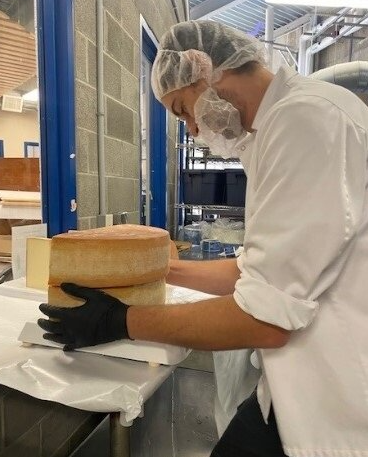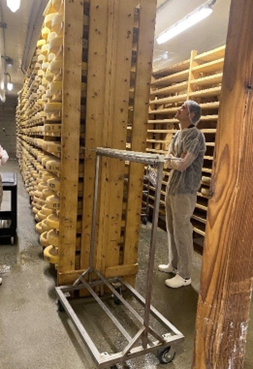By Heather Darby and Roy Desrochers, University of Vermont Extension
How do consumers want artisan cheese to taste, and how can producers make such cheese? The answers to these questions are critical to expanding the market for artisan cheese—and perhaps other dairy products. The Northeast Dairy Business Innovation Center (NE-DBIC) funded a University of Vermont Extension project to explore these questions and get some answers.
UVM Extension used an innovative sensory-directed approach to understand artisan cheese flavors and factors that might affect artisan cheese sensory qualities identified by consumers. Key to the study was creating a reliable way to make objective measurements to understand artisan cheese flavors that consumers want and to identify factors that may affect those flavors. No mechanical instrument in the world can match the human nose in its ability to detect cheese flavor compounds. So a panel of UVM Extension personnel were trained to objectively assess artisan cheese samples provided by Jasper Hill Farm in Greensboro and Spring Brook Farm Cheese in Reading. The sensory method they used, Profile Attribute Analysis (PAA), is based on the original Flavor Profile Method developed by Arthur D. Little, Inc., which has been used around the globe for decades to develop market-leading food products.
The objective taste data that UVM trained tasters generated was correlated with subjective consumer responses, such as overall likeability, and other objective cheese data, including levels of healthy fats, microbiological profiles, and chemistry. Our all-star project team included cofounder and cheesemaker Mateo Kehler from Jasper Hill Farm, and cheesemakers Lisa Griffin and Frankie Buckley from Spring Brook Farm Cheese, all of whom provided extensive knowledge about cheese and the cheese making process, as well as the cheese products used in this study. The technical team included UVM’s Dr. Jana Kraft, who analyzed the cheeses’ fatty acids; and two Tufts faculty: Dr. Benjamin Wolfe and Dr. Scott Frost, our microbiology and chemistry experts, respectively. UVM’s Roy Desrochers, a global sensory expert, managed the sensory component of the research, including the trained taste panel and innovative consumer testing using the Product Attribute Elicitation Method, commonly referred to as PEM.
What did we learn? We confirmed that consumer preferences for cheese-flavor quality have not changed since Covid-19. Specifically, we found that well-established metrics based on the Flavor Leadership Criteria still hold true. In these metrics, high-quality cheese flavor has an immediately identifiable flavor that is well-balanced and complex, with a compatible mouthfeel, no odd aromas or flavors, and a short aftertaste. We found that consumer preference data for the core drivers of cheese flavor were consistent with data that was well-established before the pandemic.
We found that microbial profiles matter to cheese-flavor quality and that cheese-storage conditions can easily influence whether different cheese types taste different or similar. For example, different types of cheeses stored in their own isolated spaces had different microbial profiles and tasted different from each other. By contrast, different types of cheeses stored in the same space had similar microbial profiles and common flavor characteristics.
We found that artisan cheeses with higher levels of healthy fatty acids had higher sensory quality and were more liked by consumers. Cheesemakers can use this information to develop unique marketing messages such as, “tastes great and contains healthy fatty acids.”
We identified chemical compounds such as acetic acid 2-methylpropyl ester and propanoic acid hexyl ester that contributed to the unique taste of cheese, whether it was buttery and creamy or stinky and sweaty. We can now look for sources of these compounds at the farm or in the cheesemaking process to engineer the cheese for more or fewer of these tastes.
Most importantly, we were able to develop a reliable cheese-flavor quality index that can be used moving forward to understand additional factors at play. In addition, we can apply sensory and consumer knowledge from this study to other areas of the dairy industry, including grass-fed milk and yogurt.
To learn more about this study, check out our webinar series on YouTube. It can be found in the UVM Extension Northwest Crops and Soils section under the series name “A Sensory Directed Approach to Understanding Artisan Cheese.” Watch the whole series or enjoy one of the single webinars focused on the sensory qualities and flavor of cheese, consumer testing, healthy fats analysis, or microbiology at bit.ly/uvm-sensory-research

Smelling cheese chemistry using an Odor Detection Port at Tufts University

Preparing cheese samples at Jasper Hill Farm

Selecting cheese samples at Spring Brook Farm Cheese

